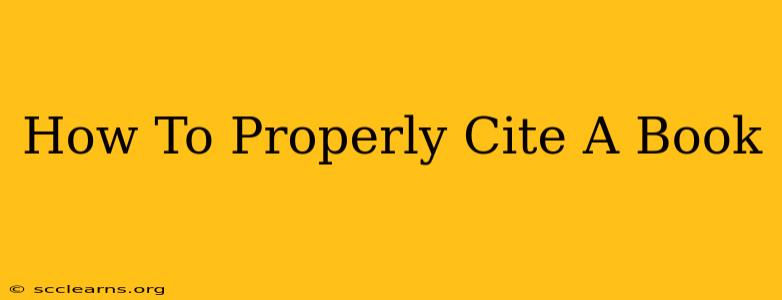Properly citing your sources is crucial for academic integrity and avoids plagiarism. Knowing how to cite a book accurately demonstrates your research skills and allows readers to easily locate the sources you've used. This guide will walk you through the process, covering different citation styles.
Understanding Citation Styles
Before we delve into the specifics, it's important to understand that various citation styles exist, each with its own formatting rules. The most common styles include:
- MLA (Modern Language Association): Primarily used in the humanities.
- APA (American Psychological Association): Commonly used in social sciences, psychology, and education.
- Chicago/Turabian: Offers both a notes-bibliography and author-date system, frequently used in history and other humanities disciplines.
Choosing the correct style depends on your instructor's or publication's guidelines. Always check the specific requirements for your assignment or publication.
Core Elements of a Book Citation
Regardless of the citation style you use, most book citations will include these core elements:
- Author's Name: Last name, First name (or First initial. if only initial is provided).
- Book Title: Italicized.
- Publisher: Name of the publishing company.
- Publication Date: Year of publication.
- Edition (if applicable): Specify if it's a second, third, or later edition.
- Location (if applicable): City and state (or country) of publication. Some styles omit this.
Examples of Book Citations in Different Styles
Let's illustrate with an example book:
Book: The Great Gatsby by F. Scott Fitzgerald, published in 1925 by Scribner.
Here's how you would cite this book in different styles:
MLA Citation
Fitzgerald, F. Scott. The Great Gatsby. Scribner, 1925.
APA Citation
Fitzgerald, F. S. (1925). The Great Gatsby. Scribner.
Chicago/Turabian (Author-Date) Citation
Fitzgerald, F. Scott. 1925. The Great Gatsby. Scribner.
Chicago/Turabian (Notes-Bibliography) Citation
- F. Scott Fitzgerald, The Great Gatsby (Scribner, 1925).
(This would appear as a footnote or endnote, with a corresponding bibliography entry. The bibliography entry would be similar to the Author-Date example above, but without the year at the start.)
Citing Edited Books and Anthologies
When citing an edited book or an anthology, the structure is slightly different. You cite the editor(s) instead of the author(s), and you may need to cite a specific essay within the book as well.
Example:
Edited Book: Critical Essays on The Great Gatsby, edited by Michael Meyer, published by Cambridge University Press in 2010.
MLA Citation (Entire Book):
Meyer, Michael, editor. Critical Essays on The Great Gatsby. Cambridge University Press, 2010.
MLA Citation (Specific Essay):
Smith, John. "Symbolism in The Great Gatsby." Critical Essays on The Great Gatsby, edited by Michael Meyer, Cambridge University Press, 2010, pp. 50-75.
Handling Multiple Authors and Editors
If a book has two authors, list them in the order they appear on the title page, separated by "and." For three or more authors, list the first author followed by "et al." (in APA and MLA styles) or use the first author followed by "and others" (in Chicago style). The same principle applies to edited books with multiple editors.
Online Books and E-books
Citing online books requires additional information, such as the URL or DOI (Digital Object Identifier). Always include the access date if the URL might change. The specific formatting will vary depending on the style guide.
Conclusion
Mastering the art of citing a book is essential for academic success. By understanding the core elements and the nuances of different citation styles, you can confidently and accurately attribute your sources, strengthening the credibility and validity of your work. Remember to always double-check the specific requirements of your assignment or publication to ensure you're using the correct style and formatting.

